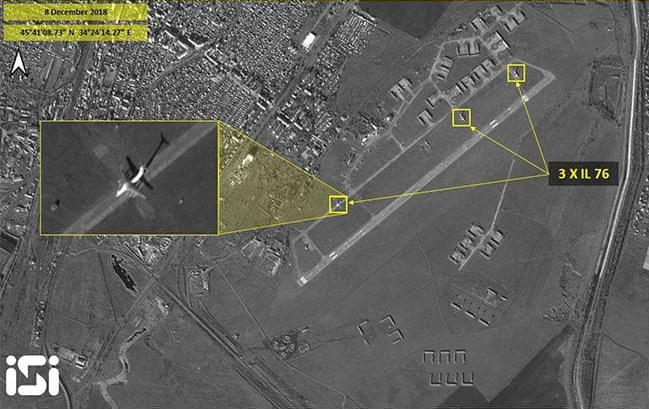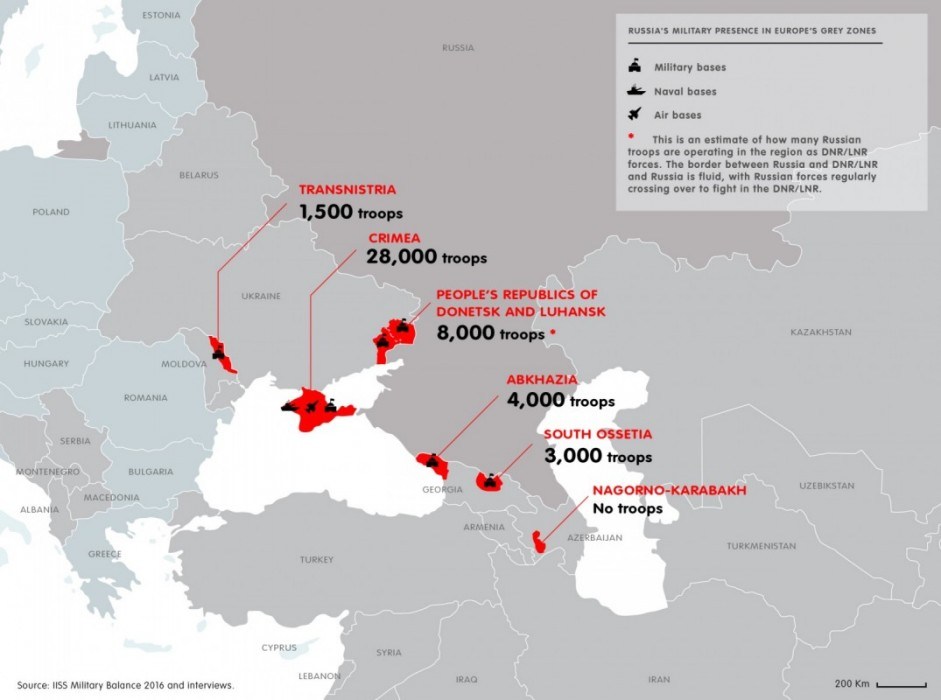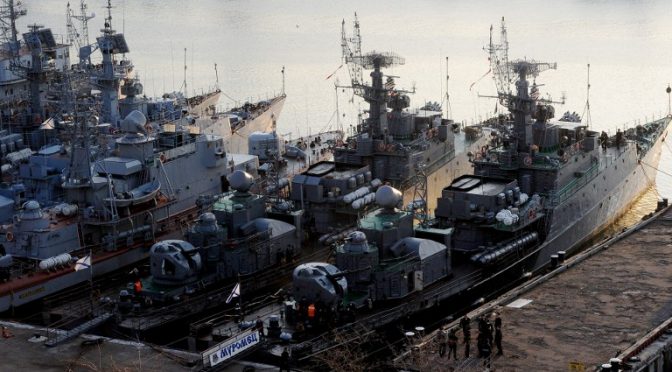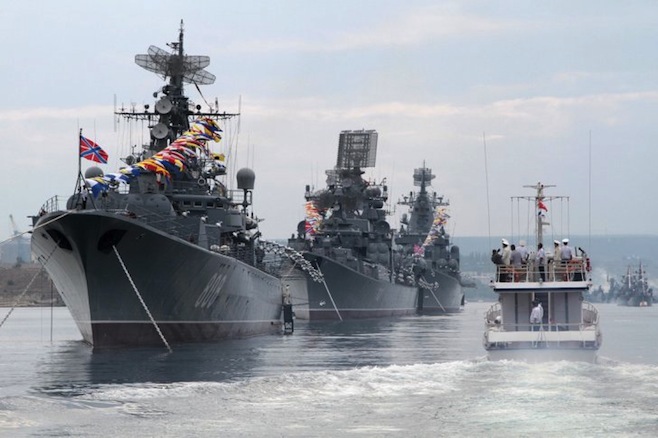This “parallel legal reality” is not limited to Russian missiles which violate the Intermediate-Range Nuclear Forces (INF) Treaty. The general style of Russian foreign policy aims to impose a new form of international relations. Russia relies more on armed forces than on mutual agreements; on pressure and coercion of a neighboring country than on cooperation.
Important to keep in mind is the tactic of small steps. Crimea, Donbas, the Azov Sea, further militarization in Crimea and near the Ukrainian borders... This sequence is very logical and consistent, yet each next step is little different from the previous one. Unless shocked by some horrible and mass action, the West wouldn’t respond. And Russia tries to avoid daunting others, though it works day to day with a clear purpose. This work can be clearly revealed by recent militarization of Crimea and concentration of troops near Ukrainian borders.
Further militarization
The rapid militarization of Crimea becomes a threat not only for Ukraine but for Europe as well due to Russian missile armament deployed to the annexed peninsula, according to data from the Ukrainian Defence Intelligence. A militarized Crimea has led to Russia becoming the most powerful player in the Black Sea region, having a well-fortified position in Crimea, where the Russian fleet is almost unreachable due to strong support from the land. Ships can perform tasks in the whole Black Sea or even some parts of the Mediterranean Sea and then come back under the strong protection of missiles and counter-air defence systems located in Crimea.
Russia has been building up armed forces in Crimea since the annexation in 2014, yet the process accelerated recently with Russian blockade of the Azov Sea and the growing need of aggressor to secure by military power its own illegal claims for Crimea or Azov Sea.
Vadym Skibytskyi, a representative of the Main Directorate of Intelligence of the Ministry of Defense of Ukraine, said that "about 29 anti-ship missile systems ‘Bastion’ and ‘Bal’ have been deployed to the coast of the Sea of Azov, which allows covering the entire area of the Azov Sea. In the coastal areas of the Azov Sea, there are about 150 combat aircraft, 62 combat helicopters, and 6 radio-electronic intelligence systems that can suppress our system of troop control and communications system.”
Vadym Skibytskyi also reported that, in addition to the numerous Russian troops, the Crimean peninsula also now hosts new armament and weapons, which were not there before 2014. Vadym Skibytskyi mentioned destroyers, submarines equipped with “Kalibr” missiles, antiship complexes, combat aircraft, especially Su-27, Su-30. Also, a helicopter regiment was recently deployed in Dzhankoi town in the North of Crimea, close to the line of demarcation with Ukraine.

Dzhankoi is becoming an even more militarized town because at least 3 heavy IL-76 cargo landed recently on its air base besides the helicopter regiment. Last but not least, one of the “Pantsyr-S” complexes was located in the town.
On 29 November, Crimea was fully covered by the "Pantsyr-S" complex, equipped with automatic guns and guided missiles with radio command guidance, and with infrared and radar surveillance. It is designed to protect small objects from airborne attacks - both airplanes and unmanned aerial vehicles, as well as to attack ground targets and troops.

On 6 December, a party of “Kalibr” missiles was sent from Novorossiysk in Russia to Sevastopol in Crimea. Some of these missiles can reach a ground target from a distance of up to 2000 km, as was witnessed when a Gepard-class frigate and three Buyan-M class Russian Navy corvettes, part of the Caspian Flotilla launched 26 Kalibr-NK system cruise missiles 3M14T from the Caspian Sea at 11 targets in Syria.
Already quite well known is the story of Russian “Iskanders” which can reach at least the whole Eastern and Southern Europe when situated in Crimea. This threat was admitted in the recent statement of foreign ministers of NATO countries accusing Russia of violating The INF Treaty.
The rapid increase of Russian tanks and vehicles near the eastern border of Ukraine was already reported.
The absence of a widespread rigid response by actions is what Russia is actively testing in order to implement its strategy further.

The Russian strategy
The Russian strategy, as well as the issue of long-distance missiles and Russian industrial capabilities for further army development, were analyzed in recently released report “Strategic appraisal. Naval forces of Ukraine, 2018,” which was prepared as a result of the Strategic Appraisal Seminar conducted in April 2018 by the Navy Headquarters of Ukraine and the US Defense Governance and Management Team in the framework of the Navy Strategy 2035 project.
Below we provide its main findings.
Regarding strategy, Andrew Fink, PhD candidate at the University of Leiden writes, that Russia has adopted a “Bastion strategy”:
“A bastion strategy aims to create a territory where own nuclear ships can cruise safely.
A bastion needs four things:
1) to be easily defendable to prevent enemy ASW [anti-submarine warfare - Ed] assets from getting too close
2) missiles capable of reaching their targets even from this “protected” area.
3) boats to carry these missiles
4) bases with infrastructure for handling nuclear weapons.
The Russian Federation already has all these elements in the Black Sea. After the seizure of Crimea, the conditions are suitable for Russia to build a low-cost cruise-missile bastion in the northern Black Sea. Russia’s Black Sea fleet is not a defensive one but a major offensive striking force for Russia in Europe, and could be their major intermediate-range nuclear force in the region.”
As captain Anatoliy Kvasov writes, Russian trainings concentrate on a further attack in the Black Sea region.
“Regular combat trainings are conducted by the Russian Armed Forces to practice combat actions focused on the armed conflict in the Black Sea region, including practicing amphibious landing operations and destruction of critical infrastructure on the coast in the operational depth. For example, in April 2018, approaching designated landing site, the landing ships of the Russian Black Sea Fleet conducted live fire at the coast using artillery and unguided rocket complexes at targets that simulated fire positions of the counter-landing defense of the opposite forces.”
The last important point regarding the Russian military and foreign strategy is the doctrine of “limited sovereignty,” described by Mykola Kapitonenko, PhD and member of “Ukraine Analytica”:
“Foreign Policy Concept of the Russian Federation dated 30 November 2016 in Part IV is dedicated to regional priorities. [...] There is a rather lofty agenda [...], part of which has been revealed in president Putin’s policy essay ‘The New Integration Project for Eurasia: the Future in the Making’ published back in October 2011. In the article he dwells upon the perspective and role of integration processes on the post-Soviet space. Russia needs the new integrational ideology, the method and the instrument for the preservation of influence over the countries on the post-soviet space.
[...]
Soft power is one more Russia’s regional policy tool, the one which efficiency has been seriously undermined with decisions of 2014 toward Ukraine. ‘Russian world’ (Russkiy mir) doctrine remains its main element – that is existence beyond Russia’s borders of minorities with a Russian identity whose rights should be protected. Some of its key elements have been dwelled upon by V. Putin in his article ‘Russia: National issue.’ ‘Russian world’ mostly consists of a set of elements of linguistic, religious, and world-view identity, spreading its own mythology onto citizens of neighboring countries.”

Regarding the Ukrainian response to this Russian strategy, Andrew Fink, PhD candidate at the University of Leiden, writes (emphasis ours):
“The Ukrainian Navy would have to invest in domain-awareness capabilities, such as surveillance radars and reconnaissance platforms. For tracking Russia’s submarine fleet, this would require more acoustic sensors, UUVs [Unmanned underwater vehicles — e.d.] to carry these sensors into Ukrainian waters currently denied by Russian naval forces, and other anti-submarine warfare equipment, as well as the necessary analytical expertise in naval intelligence. Western aid will probably be indispensable in achieving the necessary technical and training standards. This mission would make the Ukrainian Navy a strategic asset to both Ukraine and to Europe, but it requires significant investment in non-traditional naval reconnaissance platforms.
The Ukrainian Navy should also invest attention in describing the Russian cruise missile threat to friendly navies in order to draw attention to the issue, and possibly, to attract further support for the development of the Ukrainian Navy from Western allies interested in countering this threat.”
Missile threat
“The critical security issue linked to the Black Sea region is nuclear security,” Andrew Fink writes in his report. “The Russian nuclear weapon that targets a European city might be waiting on its missile in Ukrainian territorial waters. For any NATO member, the atomic weapon that will incinerate the base of the 6th fleet near Naples, or Incirlik Air Base in Türkiye, or destroy a carrier group in the Eastern Mediterranean, may be launched from Ukrainian territorial waters.
There is evidence that Russia is building a naval bastion in the northern Black Sea that can target the region with nuclear-armed Kalibr cruise missiles. This area is an ideal naval bastion that already hosts a fleet of warships capable of launching long-range cruise missiles and already has the infrastructure to handle nuclear weapons.”

Andriy Klymenko, an expert from the Crimean department of the Maidan of Foreign affairs, describes the issue with more details:
“Before the first combat employment of the Kalibr cruise missiles, which took place on 7 October 2015, it was considered that their range is 300 km. During the first combat employment in Syria, missiles struck targets at distances over 1500 km. On 22 October 2015, the Chief of the combat training directorate of the Russian Navy Headquarters, Admiral V. Kochemazov informed that the sea-based cruise missiles Kalibr have a striking range up to 2,000 kilometers. Thus, Kalibr missiles of the Russian Federation Black Sea Fleet ships launched from Sevastopol area are capable, at least, of reaching targets in the Baltic States, Poland, the Czech Republic, Slovakia, Austria, Romania, Bulgaria, Georgia, Armenia and Azerbaijan, Greece, including the island Crete, all the Balkan states, Türkiye, Cyprus, Syria, Lebanon, Israel, Iran and Iraq, the coast of Egypt, southern Italy. When positioning the launch position of the missile ship in the southwestern part of the Black Sea, for example, in the vicinity of the entrance to the Bosporus, the Kalibr missiles are capable of covering almost the entire territory of Italy, including the Island of Sicily.
Mobile shore-based missile complex Bastion with Onyx cruise missile is capable, same as Kalibr, not of firing not only at ships, but also at small-size land targets, with a likely range of 600 kilometers. Bastion, if launched from the area near Sevastopol, is capable of striking, in particular, land targets in the coastal areas of all Black Sea countries. It can also be used with a nuclear warhead.
Operational and tactical ground mobile missile complexes Iskander officially have approximately the same range – 500 km and capable of carrying a nuclear warhead up to 50 kilotons. However, many experts believe that the official missile range is underreported in order to hide the violation of the Intermediate-Range Nuclear Forces Treaty (INF), and the real range of this cruise missile is 2,000-2,600 km.
In general, coastal ground-based missile complexes Iskander, Bastion and sea-missiles Kalibr on ships of the Russian Federation Black Sea Fleet, are situated on the occupied Crimean peninsula, in combination with deployment plans of Tu-22M3 missile-carrier aircrafts, poses threat not only, as it was thought earlier, to the entire Black Sea coast, but also for the whole Europe, especially its southern flank.”
It’s also important that sanctions have a really strong impact on Russian capacities, according to Andriy Klymenko. Sanctions heavily damaged Russian possibilities for the construction of new ships. Sanctions were particularly painful for the program of modernization of the Russian Black Sea Fleet. In fact, the program for building new surface ships was disrupted in the middle. The main reason for this was the prohibition of supply of the Ukrainian and German engines for three new missile frigates of the 11356 project “Admiral Grigorovich” type and for the three new missile corvettes of the project 2163.
Therefore, the actions of the International community really influence Russia. However, taking into account the recent development of the situation and further militarization of Black Sea region, new means of influence should be used.
Capabilities of Russian military industry in Crimea
Tetiana Guchakova from the Crimean Department of Maidan of Foreign Affairs, writes that the aggressor received 13 Ukrainian companies that were part of the state-owned consortium Ukroboronprom as “trophies” after the occupation of Crimea. They were joined by new enterprises that changed the focus on military orders: Shipbuilding Plant Zalyv (Kerch), Sevastopol Marine Plant, Uranis-Radiosystemy (Sevastopol), Electric Welding Plant SELMA (Simferopol), CDB Koral (Sevastopol) and others. These industrial capacities make it possible for Russia to build up armed forces in the Black Sea much faster.
“According to the Government of the Russian Federation, 16 enterprises of the Russian Defense Industry are located on the territory of Crimea and Sevastopol. 10 – shipbuilding, three – aviation, two – conventional weapons production and one – electronics. The number of employees as of August 2017 was 8,300 people.
Since 2015, the plant specializing in torpedoes and naval launchers in the village of Ordzhonikidze (near Feodosia) has been actively restored in order to create a base for maintaining nuclear armament of the fleet. The site perimeter was equipped with modern types of alarm systems. Most probably, this will be the site for testing of the new types of underwater weapons, which was announced by the President of the Russian Federation Vladimir Putin in his message to the Federal Assembly on March 1, 2018.
The shipbuilding plant ‘More’ in Feodosia in 2016, after being ‘transferred’ into the federal ownership of Russia, has started to build the first of 3 small missile ships under the new project 22800 (‘Karakurt’) named ‘Shtorm’ for the Black Sea Fleet of Russia.
In mid-June 2017, it was also reported that Russia plans to resume production of air-cushioned landing ships ‘Zubr’ under the project 12322, capable of delivering 3 tanks with the capacity of up to 150 tons or 10 armored personnel carriers with marines to the unimproved shore. Construction of the first ‘Zubr’ must begin in 2018.

The Kerch Shipbuilding Plant ‘Zaliv’ is actively searching for orders (this plant has one of the largest shipbuilding docks in Europe – 364 meters long and 60 meters wide, no equivalents in the Russian Federation). It was de facto placed under control of Zelenodolsk A.M. Gorky plant (Tatarstan) and executes part of its orders. The number of employees increased by 2.5 times to 2,600 people. As of 1 January 2018, the plant ‘Zaliv’ constructs two patrol ships under the project 22160 ‘Pavlo Derzhavin’ and ‘Sergei Kotov’ for the Russian Black Sea Fleet and the main ship of this project ‘Vasilii Bykov’ has been finished.
[...] Russia has changed its initial plans for loading shipyards in Crimea and Sevastopol, rejected an idea to construct large civil vessels, since the certificate of origin saying ‘Crimea, Russia’ is not recognized anywhere in the world. The only option was military orders".
The bottom line
Taking all these facts into account, it becomes obvious that the longer Russian military presence and growth is tolerated in Crimea, the more dangerous and powerful it becomes. It’s a problem not only for Ukraine but for the whole of Europe because the Russian strategy of small steps has no limits and spreads slowly everywhere until opposed by strict measures. Otherwise, for what other purpose does Russia so rapidly and decisively build up its armed forces in the Black Sea, including long-distance missiles and nuclear weapons?
As Stephen Blank, Ph.D. and a senior fellow at the American Foreign Policy Council writes, Russia holds less and fewer cards to use, but the one main card is the threat of actual use of force. It becomes only stronger and more likely to be put on the table if all other opportunities are soon lost. Therefore, “it is essential to deprive Putin of opportunities to threaten force against the US, its NATO allies and partner states like Ukraine. It is our strategic imperative to bring home the costs of this war to Putin, his entourage and the Russian people. Therefore the Western response must not be proportionate. Instead, the punishment must visibly exceed the crime to deter Russia from similar operations in the future.”

